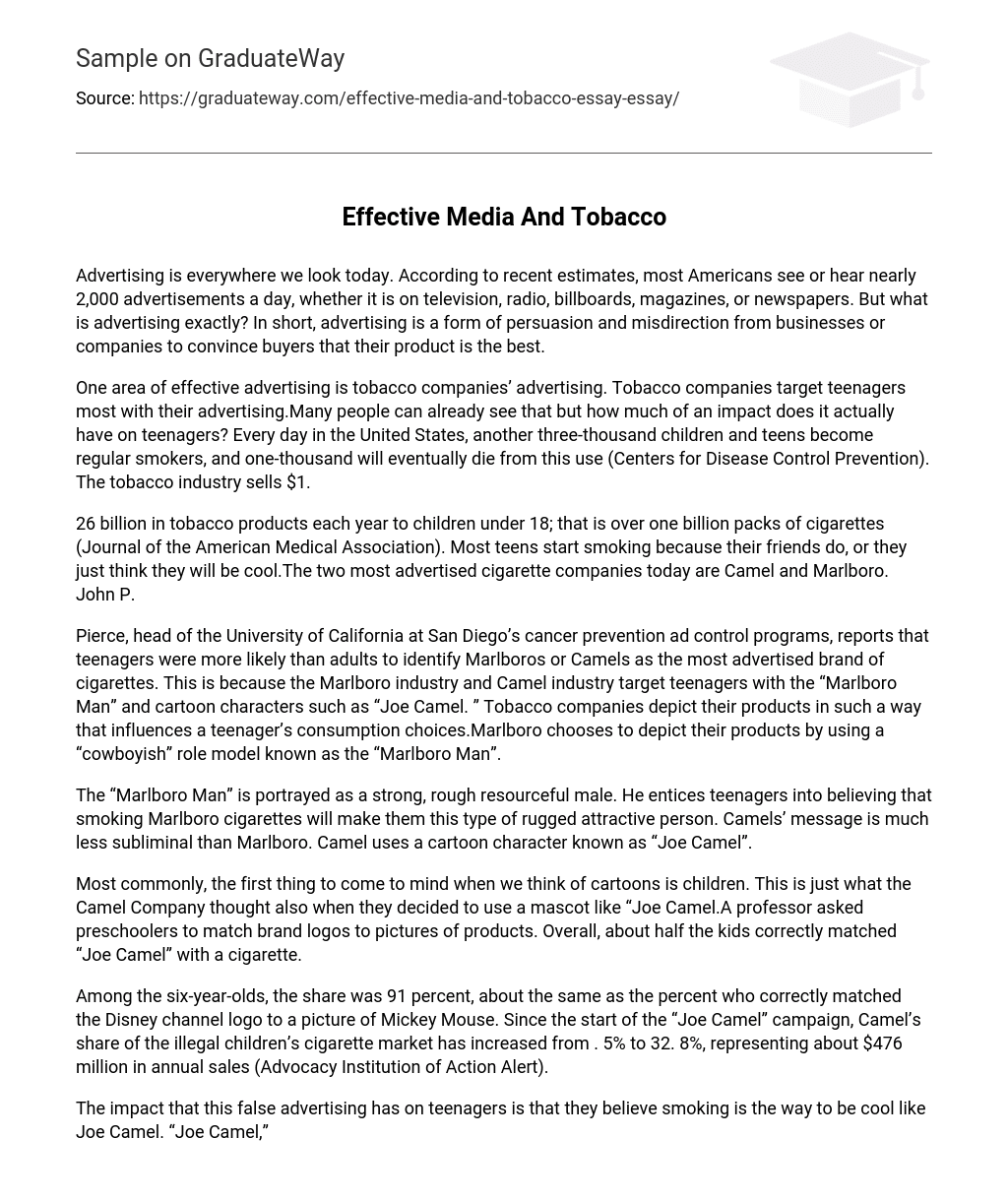Advertising is everywhere we look today. According to recent estimates, most Americans see or hear nearly 2,000 advertisements a day, whether it is on television, radio, billboards, magazines, or newspapers. But what is advertising exactly? In short, advertising is a form of persuasion and misdirection from businesses or companies to convince buyers that their product is the best.
One area of effective advertising is tobacco companies’ advertising. Tobacco companies target teenagers most with their advertising.Many people can already see that but how much of an impact does it actually have on teenagers? Every day in the United States, another three-thousand children and teens become regular smokers, and one-thousand will eventually die from this use (Centers for Disease Control Prevention). The tobacco industry sells $1.
26 billion in tobacco products each year to children under 18; that is over one billion packs of cigarettes (Journal of the American Medical Association). Most teens start smoking because their friends do, or they just think they will be cool.The two most advertised cigarette companies today are Camel and Marlboro. John P.
Pierce, head of the University of California at San Diego’s cancer prevention ad control programs, reports that teenagers were more likely than adults to identify Marlboros or Camels as the most advertised brand of cigarettes. This is because the Marlboro industry and Camel industry target teenagers with the “Marlboro Man” and cartoon characters such as “Joe Camel. ” Tobacco companies depict their products in such a way that influences a teenager’s consumption choices.Marlboro chooses to depict their products by using a “cowboyish” role model known as the “Marlboro Man”.
The “Marlboro Man” is portrayed as a strong, rough resourceful male. He entices teenagers into believing that smoking Marlboro cigarettes will make them this type of rugged attractive person. Camels’ message is much less subliminal than Marlboro. Camel uses a cartoon character known as “Joe Camel”.
Most commonly, the first thing to come to mind when we think of cartoons is children. This is just what the Camel Company thought also when they decided to use a mascot like “Joe Camel.A professor asked preschoolers to match brand logos to pictures of products. Overall, about half the kids correctly matched “Joe Camel” with a cigarette.
Among the six-year-olds, the share was 91 percent, about the same as the percent who correctly matched the Disney channel logo to a picture of Mickey Mouse. Since the start of the “Joe Camel” campaign, Camel’s share of the illegal children’s cigarette market has increased from . 5% to 32. 8%, representing about $476 million in annual sales (Advocacy Institution of Action Alert).
The impact that this false advertising has on teenagers is that they believe smoking is the way to be cool like Joe Camel. “Joe Camel,” being a representative for Camel cigarettes, is a bad image for children and teenagers. In reality, however, tobacco kills more than two and a half million people prematurely every year world wide (World Health Organization). Smoking also kills more Americans than alcohol, cocaine, crack, heroin, homicide, suicide, automobile accidents, fires, and AIDS combined each year (Centers for Disease Control).
It was reported in recent studies that since a child’s body has not yet fully developed and matured until the age of 17. So if a child starts smoking during this time and decides to quit in later years, there is no chance of their lungs ever restoring themselves to their fullest health. Although these cigarette advertisements are everywhere, there is also an equal, if not more, amount of anti smoking advertisements. Everyone in the state of Arizona should know the phrase “tobacco, tumor causing, teeth staining, smelly puking habit.
” This commercial is shown in Arizona only.It is paid for by the law that increased taxes on cigarette sales by $. 50. This went into effect approximately four years.
This approach is used to make smoking look unattractive and repulsive. It has also put a drastic dent in the number of teens that smoke. Ever since the commercials had started to air, the number of smokers has decreased. The 1-800 numbers shown on television were very helpful.
More than half their callers started smoking in their teenage years and now, 20 or so years later, they are wanting to quit and asking for help.A study estimated that teenagers annually consume 516 million packs of cigarettes. Our children should not be able to recognize an enemy like “Joe Camel” as well as they recognize their hero Mickey Mouse. If the advertising stops then the children and teenagers will be less prone to have to act cool and experiment with smoking.
Tobacco advertising influences and affects the American teenagers today in a strong way, and the only solution is for it to stop.





